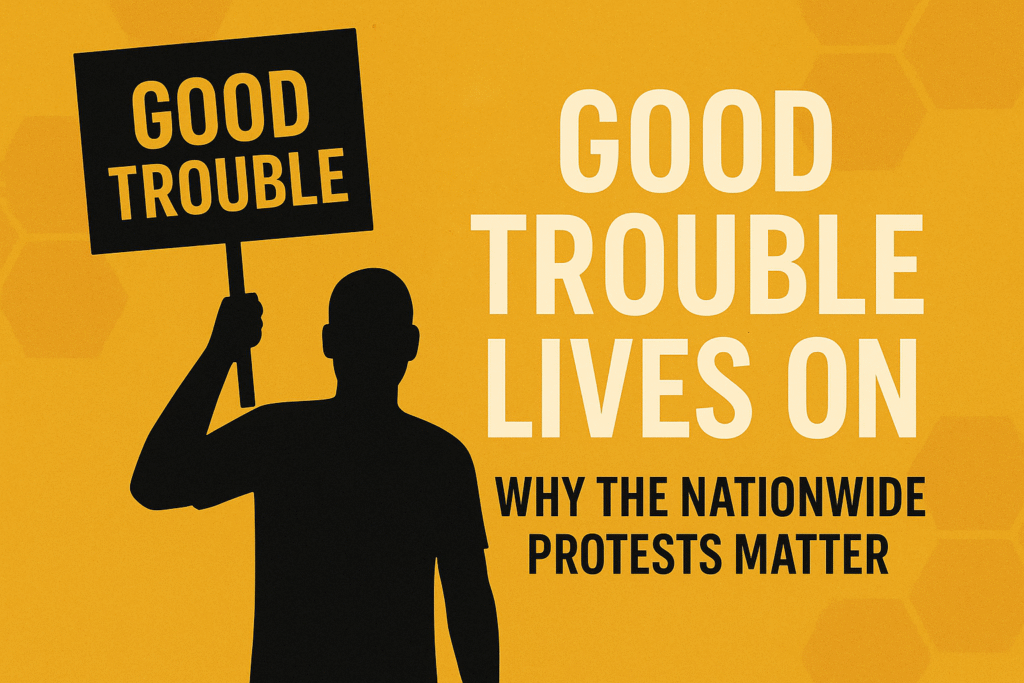“Good Trouble Lives On”: Why the Nationwide Protests Matter

“Good Trouble Lives On”: Why the Nationwide Protests Matter
In July 2025, a wave of protests under the banner “Good Trouble Lives On” swept through cities across America and beyond. Building on the legacy of civil rights icon John Lewis, this movement addressed pressing concerns about immigration, healthcare, and democratic governance. But what fuels it—and why does it resonate now?
What is “Good Trouble Lives On”?
The phrase comes from John Lewis, who encouraged activists to stir constructive disruption—or “good trouble”—for justice. On July 17, 2025, tens of thousands gathered nationwide to protest recent federal policies on deportations and budget cuts. #GoodTrouble protests spread quickly across all 50 states and Puerto Rico, including California, Florida, and Colorado :contentReference[oaicite:1]{index=1}.
Origins and Organization
This effort wasn’t spontaneous—it involved coordinated planning by groups like the American Constitution Society, Black Voters Matter, Indivisible, the National Urban League and more. They rallied communities to the cause, emphasizing peaceful demonstrations to uphold democracy and equality :contentReference[oaicite:2]{index=2}.
Local Mobilization
More than 100 events took place in California alone, from San Francisco to Los Angeles. Other hubs included Miami, Denver, New Haven, Wilmington and beyond. This widespread mobilization reflects shared concern across diverse communities :contentReference[oaicite:3]{index=3}.
What Are Protesters Demanding?
There are three key calendar demands:
- Immigration reform – Against mass deportations and “third-country” deportations
- Healthcare protections – Protesting federal healthcare budget cuts
- Defend democracy – Challenging authoritarian impulses from the federal government
Why Now? The Political Landscape in 2025
This moment unfolds amid a volatile political climate. Federal actions—like rising deportations to third countries and major healthcare defunding—have raised alarm bells nationwide. Meanwhile, public concern over democratic integrity continues to grow.
Moreover, the protests follow a string of aggressive executive moves, ranging from immigration crackdowns to commandeering federal agencies. That coincides with a heightened sense of urgency around protecting institutional checks and balances.
International Echoes
While based in U.S. soil, Good Trouble Lives On also inspired solidarity events among Democrats Abroad and U.S. communities overseas—highlighting its global democratic resonance :contentReference[oaicite:4]{index=4}.
Impact and What Comes Next
These protests have already drawn media attention, motivated civic engagement, and prompted political responses. For example, House GOP officials began reconsidering votes impacted by this activist pressure.” Furthermore, across the executive branch, several federal departments have been asked to reevaluate their budget lines and enforcement practices :contentReference[oaicite:5]{index=5}.
For example, following nationwide demonstrations, some members of Congress signaled openness to extended funding for critical healthcare programs—a direct effect of this surge in civic activism.
What This Means for U.S. Democracy
“Good Trouble Lives On” illustrates how American democracy thrives when civil society steps in. These protests are a reminder that public pressure can drive policy change—even in polarized times.
In contrast to violent unrest or hate-motivated rallies, this movement focuses on democratic principles. That makes it significant not only politically, but morally—as a peaceful plea for accountability and equity.
Will It Maintain Momentum?
That depends largely on sustained organization. If coalitions stay united and media coverage continues, the protests could shape policy during the fall—and perhaps influence the road to the 2026 midterms.
Conclusion
The “Good Trouble Lives On” movement is more than a photo op—it’s a coordinated civic intervention rooted in historical activism. By spotlighting civil rights, political integrity, and public welfare, it underscores the enduring power of democratic engagement. As the nation watches, these thousands of peaceful voices could indeed shape the future.
FAQs
What does “Good Trouble” mean?
It refers to productive, peaceful protest in pursuit of justice—a phrase popularized by civil rights leader John Lewis.
Who organized the “Good Trouble Lives On” protests?
Coalitions including Black Voters Matter, National Urban League, Indivisible, American Constitution Society and others coordinated events nationwide :contentReference[oaicite:6]{index=6}.
Can this movement influence federal policy?
Yes—so far lawmakers in both parties have shown signs of moderating immigration and healthcare decisions, and the movement could shape upcoming fall legislative debates.